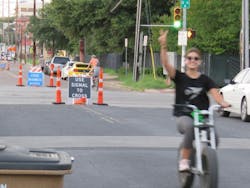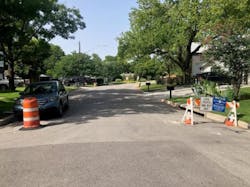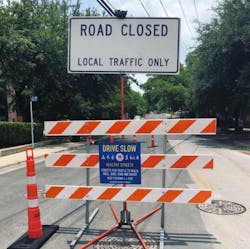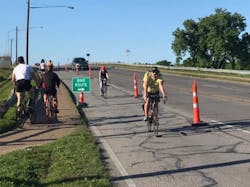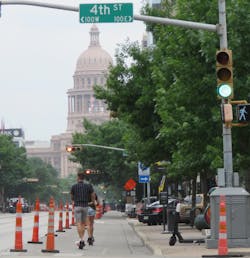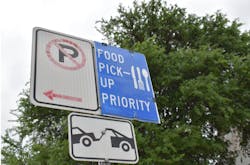Austin Transportation operations shift to meet community needs during COVID-19
The worldwide spread of the COVID-19 pandemic has had profound effects on how Austin residents and visitors use transportation and move throughout the city.
As Austinites pivoted in response to COVID-19, drastic changes in traffic patterns, business patronage, and community interaction shifted needs and priorities for the Austin Transportation Department. Data collected by the department showed:
- Travel times plummeted as automobile trips decreased, specifically during peak commute periods. This resulted in average vehicle speeds increasing alongside serious injuries and deaths in crashes.
- Trail and active transportation infrastructure became crowded with people needing places to take care of their physical and mental health needs, even after micro-mobility usage dropped 96%.
- Parking system demand fell with the introduction of city and county stay-at-home orders, but demand for delivery increased with businesses shifting to and increasing curbside offerings.
Austin Transportation staff developed several efforts to respond to the changes and provide support for the community.
Reducing speeding
As automobile trips decreased along with traffic and travel times, Austin Transportation and Austin Police Department staff observed increased egregious speeding and serious injuries and deaths in crashes. In order to change driver behavior, Austin Transportation’s Vision Zero program invested in an educational Public Service Announcement campaign on Spotify, local radio stations, Facebook, Instagram, and YouTube to raise public awareness of the issue. The script stated:
“Austin’s Vision Zero program asks everyone to respect speed limits—slowing down helps hospitals focus on coronavirus instead of injuries from avoidable car crashes. Stay home. Stay safe, and if you have to drive, slow down!”
For a minimal financial investment, the campaign was successful in reaching over 250,000 Austinites and paved the way into a long-planned revamp of the city’s speed management program which was unanimously passed by Austin City Council and lowered the speed limits of many streets citywide.
Healthy streets
Beginning in April, Austin Transportation staff began opening street space to active uses by limiting automobile access. Named the Healthy Streets Initiative, the initiative opens street space for walking, running, biking, and other activities that promote physical and mental health, while maintaining local motor vehicle access for residents, deliveries, and emergency vehicles.
Staff recognized that trail infrastructure was at capacity and community members needed additional space to maintain adequate physical distancing to limit the spread of COVID-19. Austin Transportation collaborated with the City of Austin’s Parks and Recreation and Public Works departments to open street space on Riverside Drive and Pleasant Valley Road which are adjacent to the Lady Bird Lake Trail to provide more space for pedestrians and people riding bikes to maintain physical distance from one another.
Following these initial measures, Austin City Council directed Austin Transportation (Resolution 20200507-062), to create places that promote physical and mental health and provide safe options to access jobs and services. With this directive, staff worked to open six street segments throughout the city so people could more comfortably use these low-traffic areas for activities like walking, wheelchair rolling, running, and bicycling with enough space to maintain physical distance, through the use of “soft closures.”
Austin Transportation uses various devices on Healthy Streets to open street space for walking, running, biking, and other activities that promote physical and mental health. Below are some examples of installation types:
Staff continue to evaluate street segments to be added to the program as long as physical distancing is necessary and have an extensive public engagement program to gather feedback on both future and current routes.
Congress Avenue temporary bike lanes
In addition to the Healthy Streets Initiative, Austin Transportation installed temporary bicycle lanes on Congress Avenue, from Riverside Drive to 11th Street to improve safety and ensure enough physical distance for all people using the avenue and on the Ann Richards Bridge. Often referred to as “the Main Street of Texas,” Congress Avenue has long been envisioned as a more human-centric, multifunctional complete street with a clear and attractive identity.
The temporary protected bicycle lanes present the opportunity to transition to a more permanent installation are envisioned as part of the Congress Urban Design Initiative and is a significant step toward the vision's implementation and improving safety and mobility for everyone on the Avenue.
Food pick-up priority parking zones
In order to improve community access to curbside food pick-ups, the Austin Transportation Department installed temporary customer pick-up zones in support of local restaurants that transitioned to take-out and delivery-only service. The department converted some paid on-street parking spaces near restaurants into free temporary loading zones to make room for more people to pick up food while practicing appropriate social distancing to help prevent the spread of COVID-19.
The first temporary customer pick-up zones were installed in areas with high concentrations of restaurants on blocks that did not have enough loading options and where off-street parking was unavailable. Austin Transportation created an interactive map that showed where these temporary customer pick-up zones were located.
Crews established approximately 50 curbside customer pick-up zones that make it easier for customers to check in with businesses, receive service, and move along. The zones were marked with blue and white signs that say Food Pick-Up Priority. Restaurants could request an evaluation by filling out an online contact form.


